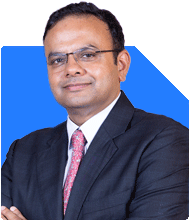Ramalingam Kalirajan |8940 Answers |Ask -Follow
Mutual Funds, Financial Planning Expert - Answered on May 16, 2025
He has an MBA in finance from the University of Madras and is a certified financial planner.
He is the director and chief financial planner at Holistic Investment, a Chennai-based firm that offers financial planning and wealth management advice.... more

Dear sir, I am currently 21 about to turn 22, I have savings of 4 lakhs which is invested in share market and can't be taken out. My monthly salary is 1 lakh. I want to accumulate 10 lakhs by next year for my sister's wedding. Is there any saving method that I could use to accumulate that much amount?
At 21, earning Rs. 1 lakh per month is a very good start.
Also, having Rs. 4 lakhs already invested shows good financial discipline.
Wanting to save for your sister’s wedding is a noble goal.
Let us now plan how you can build Rs. 10 lakhs in 12 months.
We will assess this from all angles.
We will keep the plan simple, practical and focused.
Understand Your Savings Target Clearly
You want to save Rs. 10 lakhs in 1 year.
That means around Rs. 83,000 per month.
This is more than 80% of your salary.
This will be tough, but not impossible.
You must be ready to sacrifice lifestyle for one year.
This is the first mindset shift needed now.
Review Your Current Income and Expenses
Let us understand where your salary goes.
Take a notebook. Write monthly fixed expenses.
Include rent, food, travel, phone bills, etc.
Also write any subscriptions or online spends.
Check how much is left after all this.
That leftover is your monthly surplus.
You need to increase this surplus to Rs. 80,000 or more.
You must track this every single month without fail.
Use a simple budget sheet if you want.
Cut Non-Essential Expenses Aggressively
You are young. Social life may demand spending.
But for this one year, keep expenses very low.
No online shopping unless fully needed.
No luxury dining or weekend splurges.
Avoid gadgets or travel plans now.
Also cut down entertainment, streaming and subscriptions.
Focus only on family and basic needs.
This one year of simplicity will pay off later.
Keep Emergency Buffer Aside First
Do not put 100% into saving for wedding.
Keep at least Rs. 50,000 as emergency fund.
Keep this in savings account or liquid instrument.
It is not to be touched unless truly urgent.
Emergencies come without warning. Be prepared.
This gives peace of mind during your savings journey.
Avoid New Loans or EMI Commitments
No need to take loans to save money.
Also avoid buying gadgets or phones on EMI.
EMI reduces your saving ability month after month.
In fact, reduce or close existing EMIs if any.
Being debt-free gives full control over your money.
Avoid lifestyle inflation during this 12-month period.
Don’t Touch the Rs. 4 Lakhs Already Invested
This is your long-term investment.
You said it’s not accessible, which is good.
Equity needs time to grow. Let it stay.
This is not meant for short-term use.
Also, redeeming equity before time can lead to losses.
There may also be exit load or tax impact.
So do not disturb your existing portfolio.
Open a Separate Account for Wedding Fund
Keep your sister’s wedding fund separate.
Open a new savings or investment account.
Transfer money into it every month without fail.
This builds commitment and mental discipline.
It also keeps you away from accidentally spending it.
Keep this account out of UPI apps or wallets.
Make it less accessible to avoid impulsive usage.
Choose Suitable Monthly Saving Instruments
You can’t keep all money in savings account.
You need to earn better returns on it.
Choose a safe and regular investment method.
Short-term goals need capital protection and moderate growth.
Pick instruments that allow regular monthly deposits.
Also check for liquidity and penalty rules.
Make sure it is not market-linked and high-risk.
Low to moderate risk tools suit your 12-month horizon.
Don’t Invest in Direct Funds for Short Term
You may hear about direct mutual funds.
They seem to offer higher returns due to low expense.
But they give no guidance or regular tracking support.
You must choose funds on your own completely.
Also, you must do all reviews without help.
If you choose wrong fund, it affects returns badly.
Especially for short-term goals, mistakes can cost more.
Instead, prefer regular funds through a CFP-backed MFD.
They review, guide, adjust portfolio, and ensure correct plan.
Avoid Index Funds for this Purpose
Index funds simply follow the market index.
They do not actively manage risks.
They do not shift between sectors when needed.
So, when markets fall, they also fall fully.
For a short-term goal like a wedding, this is risky.
Actively managed funds have research-based flexibility.
They adjust to market conditions smartly.
For one-year goal, active management brings better stability.
Stick to Disciplined Monthly Saving Plan
Saving Rs. 83,000 per month is not easy.
Start by fixing a standing instruction on salary day.
Automate this transfer to your wedding fund account.
Do this before spending on anything else.
If full Rs. 83,000 is not possible now, start lower.
Then increase it every 2–3 months.
If you get bonus or freelance income, add that too.
Even one missed month will delay the target.
So be strict with the system.
Find Small Extra Income Sources
Look for side income during weekends or evenings.
You can try online freelance work or part-time gig.
Even Rs. 5,000–Rs. 10,000 per month helps.
This can speed up your target savings.
Use 100% of extra income only for wedding fund.
You’re young, so energy is your strength.
Utilise free time to build this faster.
Avoid Shortcuts or High-Risk Bets
You may feel tempted by quick-return stocks.
Or your friends may suggest crypto or penny stocks.
Avoid all high-risk ideas for this goal.
Your sister’s wedding is a responsibility, not a gamble.
Don’t take chances with money meant for family event.
Safety is more important than high returns now.
Stick to low-risk saving methods with predictable results.
Track Progress Every Month Without Fail
At month-end, review your saving balance.
See if you’re on track for Rs. 10 lakhs.
If you’re falling behind, increase savings next month.
Or reduce any new unnecessary expense.
This helps you catch problems early.
Use a simple Excel or notebook for tracking.
Reviewing keeps you focused on your goal.
Do this even if you feel lazy.
Celebrate Small Wins Along the Way
Every 2–3 months, check how much you saved.
If you hit milestones like Rs. 3 lakhs or Rs. 6 lakhs, feel proud.
But don’t reward yourself with spending.
Instead, just feel mentally strong and continue.
This helps you stay motivated across 12 months.
Saving for a family event brings deep satisfaction.
Use that emotion to stay committed.
Plan for Wedding Expenses in Advance
You also need to plan how the Rs. 10 lakhs will be used.
List all likely expenses: venue, food, clothes, gifts.
Discuss with family what’s needed and what’s optional.
Try to fix a budget early.
This avoids overspending during emotional moments.
If you plan spending early, your saving will feel more purposeful.
Talk to a Certified Financial Planner Later
After the wedding, don’t stop your good habits.
You will be free from this short-term goal then.
Start building wealth for your long-term needs.
Meet a Certified Financial Planner after this year.
They will help you plan your next financial goals.
They will build your investment path with clarity.
Start mutual fund SIP through regular plans via a CFP-backed MFD.
This ensures monitoring and personalised advice.
Avoid going into investment alone without support.
Finally
Saving Rs. 10 lakhs in 12 months is ambitious.
But not impossible if you plan and act.
You are still young, so discipline matters more now.
Use this goal as a financial training ground.
It will shape your future habits and strength.
Be strict, focused, and consistent.
Every month matters. Every rupee counts.
Don’t chase fancy returns. Choose peace and certainty.
Your sister’s wedding will be a proud moment.
And so will be your financial effort behind it.
Stay committed. Stay calm. Stay focused.
You are already on the right path.
Best Regards,
K. Ramalingam, MBA, CFP,
Chief Financial Planner,
www.holisticinvestment.in
https://www.youtube.com/@HolisticInvestment
You may like to see similar questions and answers below
Abhishek Dev | Answer |Ask -Follow
Financial Planner - Answered on Aug 31, 2023
Ramalingam Kalirajan |8940 Answers |Ask -Follow
Mutual Funds, Financial Planning Expert - Answered on Jul 24, 2024
Ramalingam Kalirajan |8940 Answers |Ask -Follow
Mutual Funds, Financial Planning Expert - Answered on Nov 04, 2024
Ramalingam Kalirajan |8940 Answers |Ask -Follow
Mutual Funds, Financial Planning Expert - Answered on Nov 26, 2024
Ramalingam Kalirajan |8940 Answers |Ask -Follow
Mutual Funds, Financial Planning Expert - Answered on Apr 07, 2025
Radheshyam Zanwar |3586 Answers |Ask -Follow
MHT-CET, IIT-JEE, NEET-UG Expert - Answered on Jun 19, 2025
Radheshyam Zanwar |3586 Answers |Ask -Follow
MHT-CET, IIT-JEE, NEET-UG Expert - Answered on Jun 19, 2025
Radheshyam Zanwar |3586 Answers |Ask -Follow
MHT-CET, IIT-JEE, NEET-UG Expert - Answered on Jun 19, 2025
Radheshyam Zanwar |3586 Answers |Ask -Follow
MHT-CET, IIT-JEE, NEET-UG Expert - Answered on Jun 19, 2025
Ravi Mittal |602 Answers |Ask -Follow
Dating, Relationships Expert - Answered on Jun 19, 2025
Nayagam P P |6563 Answers |Ask -Follow
Career Counsellor - Answered on Jun 19, 2025
Nayagam P P |6563 Answers |Ask -Follow
Career Counsellor - Answered on Jun 19, 2025
Nayagam P P |6563 Answers |Ask -Follow
Career Counsellor - Answered on Jun 19, 2025
Nayagam P P |6563 Answers |Ask -Follow
Career Counsellor - Answered on Jun 19, 2025
Nayagam P P |6563 Answers |Ask -Follow
Career Counsellor - Answered on Jun 19, 2025























